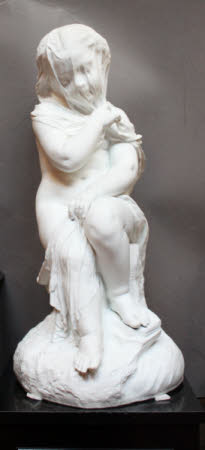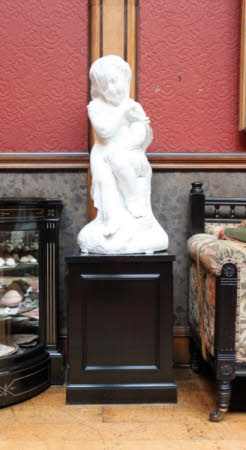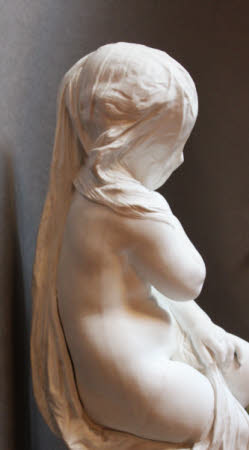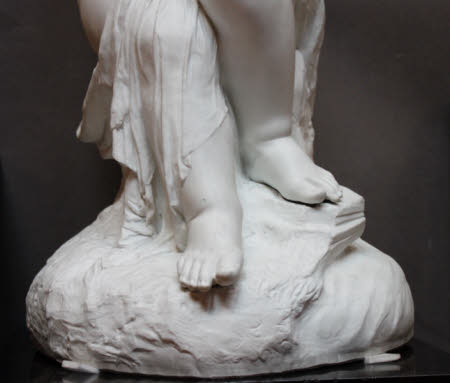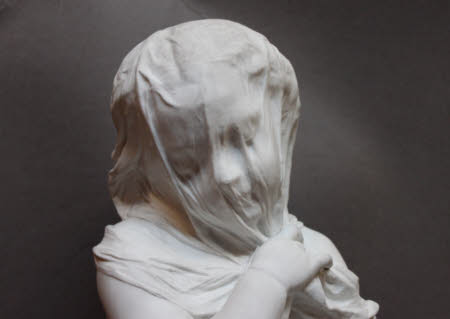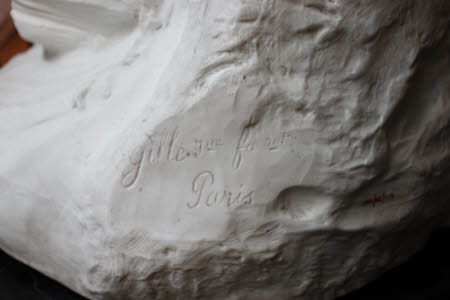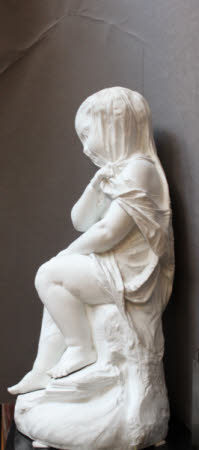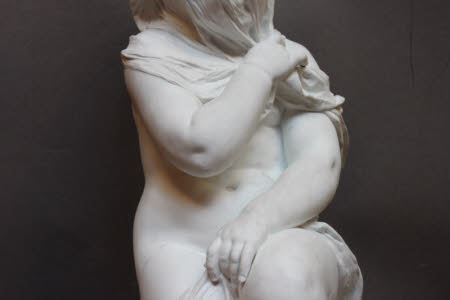A seated young girl
Gille Jeune (1798 - 1868)
Category
Art / Sculpture
Date
c. 1860 - 1868
Materials
Biscuit, Marble, Wood, Parian
Measurements
870 mm (H)615 mm (H)445 mm (W)445 mm (D)
Place of origin
Paris
Order this imageCollection
Cragside, Northumberland
NT 1231035.1
Summary
Sculpture, ceramic; Jean-Baptiste Gille the Younger (1798-1868); Young girl veiled; c. 1860-68. A biscuit porcelain statuette of a young girl, her head and part of her body covered in a diaphanous drape.
Full description
A large ceramic sculpture in white biscuit porcelain by Gille Jeune, depicting a young girl, seated upon a rock, looking downwards and to her right. She is naked but partly covers herself with a flimsy drapery, on which she is seated, and part of which she pulls up with her left hand to cover her right thigh, whilst the other end of the fabric entirely covers her head, and is held in place with the girl’s left hand. Signed on the rock, towards the back. The Parisian ceramicist known as Gille Jeune (French, 1798-1868) was born Jean-Baptiste Gille. He started his porcelain factory known as Gille Jeune in 1836, at 28, Rue du Paradis-Poissonnière (for Gille Jeune, see Plinval de Guillebon 2012, esp. pp. 257-60). Gille Jeune became one of the leading manufacturers of coloured biscuit porcelain, producing many figures copying or derived from 18th-century models. The firm took part in the 1851 Great Exhibition in London where it was awarded a Prize Medal, and also at the 1862 International Exhibition in London and the Paris Exhibition of 1867. A typical example of his work is the standing figure of a woman in fanciful eighteenth-century dress exhibited by Gille Jeune at the 1862 International Exhibition, now in the Victoria & Albert Museum (Inv. C.145-1988). After Gille's death in 1868, the firm was acquired by one of his modellers, Charles Baury and changed its name to Vion & Baury. Alongside these figures, Gille Jeune made figures, both large and small statues in white biscuit ware, which in part capitalised on and were in competition with the Parian ware produced in Stoke-on-Trent by factories such as Copeland and Minton. As with Parian, these sometimes reproduced models by well-known sculptors, for example the figure of a dog called Musette, after a model by Albert-Ernest Carrier-Belleuse, in the Metropolitan Museum of Art in New York (Inv. 1977.44). Gille Jeune made a large number of often very fine portrait busts of well-known contemporary figures, such as the Emperor Napoleon III (1808-73) or the duc de Morny (1811-65) (Plinval de Guillebon 2012, p. 71, figs. 63-65). Among surviving examples of Gille Jeune’s larger scale ceramic sculptures are the five figures of the Seasons at Hughenden Manor, some of them bought for the gardens of the house in May 1864 (NT 429120). These are very close in concept and size to the figure at Cragside, which was probably also made in the 1860s, in the latter years of Gille Jeune’s activity. The rather bizarre application of the drapery to cover the child’s entire face must reflect the briefly fashionable concept of sculpted images of women dressed in diaphanous drapery and with their faces close veiled, so that the forms of face and body would show through. Although this conceit was pioneered in the eighteenth century by the Italian sculptors Antonio Corradini and Innocenzo Spinazzi, it was revived around the middle of the nineteenth century by the Italian sculptors Raffaele Monti (1818-81), who worked mainly in Britain, and Giovanni Strazza (1818-75). No other versions of the Cragside figure are currently known. Jeremy Warren April 2022
Provenance
Armstrong collection. Transferred by the Treasury to The National Trust in 1977 via the National Land Fund, aided by 3rd Baron Armstrong of Bamburgh and Cragside (1919 - 1987).
Marks and inscriptions
On rocks, towards back:: Gille Jne fa … ant [fabricant] Paris
Makers and roles
Gille Jeune (1798 - 1868), sculptor
